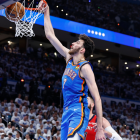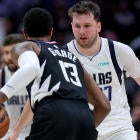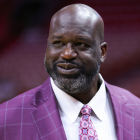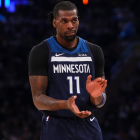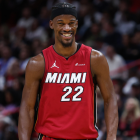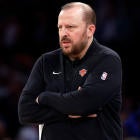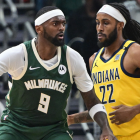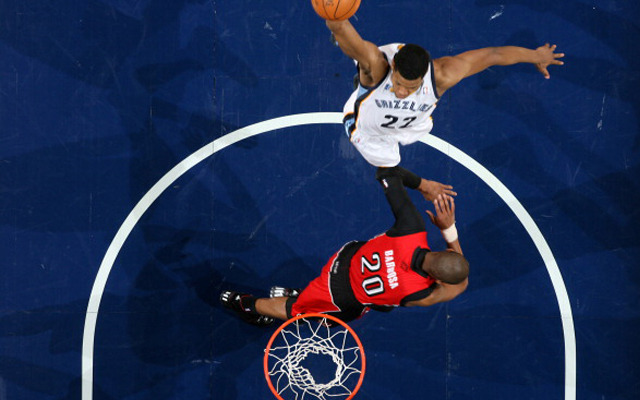 |
| Rudy Gay's arrival in Toronto is worth the price. (Getty Images) |
The Toronto Raptors just gave up an expiring contract in the form of their starting point guard and a promising young big man in order to get a 26-year-old forward who is having the worst offensive season of his career and is owed $37.2 million after this season. This comes after they signed Andrea Bargnani to a five-year, $50 million deal in 2010, Linas Kleiza to a four-year, $18.8 million deal in 2010, Landry Fields to a three-year, $18.7 million deal in July 2012 and DeMar DeRozan to a four-year, $40 million extension in October 2012.
Altogether, Raptors GM Bryan Colangelo has committed $127.5 million to four guys who really aren't guys you would kill to have on your roster, and that's before he took on Rudy Gay's contract from the Memphis Grizzlies. The Raptors are bringing in so much long-term salary that it wouldn't shock me if Colangelo ripped off a mask and revealed he was Isiah Thomas.
However, even with all of the money on the books, adding Gay to the roster was the correct move.
I agree with Rob Mahoney and Matt Moore that the money for the Raptors is bad right now. Colangelo has been so bad at his job over the years in Toronto that it would be weird to see him allowed to run this team past this season. They need a new front office with a new plan that involves the core of this team. That core is Dwane Casey, Jonas Valanciunas, Kyle Lowry, Terrence Ross and now Rudy Gay.
The rest of the parts are auxiliary components that aren't really necessary to the long-term vision. You could argue that the Raptors simply don't have a long-term vision right now. How could they, with so many bad contracts under their belts through the 2015 season? With the Rudy Gay deal, they finally have someone to build with on the wings.
Ross is a really nice player, but he's never going to be a franchise-level guy. With that said, I still think his athleticism and potential scoring ability can be an invaluable asset to a team like the Raptors. And I believe his presence helps them shape an identity that is much needed.
The question that comes up with the Raptors once you get past the money they have committed is, how do you play all of these wings together?
If this were still the early 2000s or the 1990s, I'd think it was a valid question. However, look around the landscape of the league. The NBA is becoming ruled by teams that can roll out a dynamic point guard, a defensive big man to cover up mistakes and wing players to stretch the floor not only side-to-side but also coast-to-coast. For the time being, the Raptors potentially have a lineup of Lowry, Ross, DeRozan, Gay and Valanciunas once everybody is healthy. The bench isn't ideal yet, but the structure of what the Raptors need to do with this lineup is apparent.
They need to cause chaos. That lineup is one that can pressure the ball on the perimeter, protect the rim and turn stops and turnovers into quick baskets the other way. Casey isn't the type of coach who likes to push the ball a ton (Raptors are 24th in the NBA in pace), but they are a team that benefits best when they're playing quick basketball without rushing.
What does this mean? The win-loss profiles on 82games.com break down how teams do against the top 10, middle 10 and bottom 10 in various categories. When the Raptors are playing the 10 teams that like to push the ball the most, they're just 3-10 with a net rating of -6.9. When they play the teams that like to push the ball the least, they're just 4-11 with a net rating of just -3.8.
However, when Toronto is playing that middle section of the NBA when it comes to pace, they're 9-9 with a net rating of +2.6. The Raptors need an opportunistic team on the court, instead of a slow, grind-it-out sort of team or a hectic and frenetic team. This is what they can begin to hone with Gay on the roster.
The gamble here is believing that this season in Memphis was just a rough stretch for Gay and not the signs of what's to come. Rudy has been atrocious. He's averaging 17.2 points because he's taking 16.4 shots. He has a true shooting percentage of 47.8 percent and the second-highest usage rate (25.4 percent) of his career. He's just chucking when he gets the ball.
It's possible the Lionel Hollins stagnant system was what eventually broke him down this year. There is no movement off the ball. There is only ball-stopping if you can't create a basket out of a turnover. Perhaps it breeds ball-movement roadblocks and thus infects your mindset to be a ball-stopper in the half court.
If that's the reason for Gay becoming such a poor offensive player this year, then you have to think things could be better in Toronto. It's fresh scenery, new teammates and a coach who might try to embrace what Rudy likes to do -- get buckets. Rudy Gay likes to score out of isolation sets, and he's great (but underutilized) in the post.
These are two things that the Raptors do well. In the 2010-11 and 2011-12 seasons, Gay was a top-30 player scoring in the post both years. Even with how he has struggled this season, he's still ranked 42nd in points per possessions in the post, via Synergy. Toronto is pretty good at recognizing quick post-up opportunities. They're also the best team in the NBA at scoring in isolation possessions. It seems like fitting Gay into this style of play won't be hard, and it should get his production to take a dramatic leap back to where it was before this season.
It's unclear how the Raptors will move the ball around with ball-dominant players on the court and Jose Calderon passing the ball around in Detroit. But if they can create spacing with their isolation scorers and ability to execute a decent version of the dribble-drive offense when the opportunities present themselves, I don't think a lack of traditional passers is going to be an issue.
The Raptors didn't blow up a playoff team by making this deal, so acquiring a roster full of isolation scorers is an experiment that they can use to see who might belong together and who won't when the offseason comes. And that's when it's time to put a plan into motion.
What Colangelo has put together in Toronto makes very little sense, but the team finally has a jumping-off point. DeRozan will be entering a four-year deal that looks like a crazy amount of money for the production that he puts out there. But as we've learned in the league time and time again, no contract is untradeable. He has been virtually the same player for three seasons now, but you can convince other GMs that a scoring wing in his mid-20s is worth a flier.
Many people assume the Raptors will amnesty Kleiza this summer. But he only has one year left on his deal, assuming he doesn't decline his player option and head back to Europe. If you get rid of Colangelo, then you no longer have a front-office attachment to Bargnani. If you amnesty him, the flirtation with the Raptors and the luxury tax no longer becomes a concern.
The Raptors have 12 players under contract for next season for a price tag of roughly $72.9 million. That's dangerously close to the luxury tax when you factor in a rookie-scale contract (their pick is top-3 and 15-30 protected). However, the Raptors still have plenty of wiggle room. If they get Kleiza out of the NBA and back to Europe, that saves them $4.6 million. Amnesty Bargnani, and they clear another $10.7 million. Decline the team option on John Lucas III, and you save another $1.5 million.
That could potentially bring them down to $56.1 million. That's not only under the salary cap, but it's also far away from the luxury tax. If they end up with a top-3 pick, they'll gladly give that money to one of the best players in the draft and they'll be adding talent to their roster. If they end up giving that pick to the Thunder, they still have enough flexibility to add cheap players as they figure out their core.
And from there, you're hoping a new front office can find ways to pawn off guys who have two years left on their contracts. You're figuring out how to convince someone in a trade that Landry Fields is worth taking a flier on for a year before he enters his valuable expiring contract season. It sounds like pie in the sky, but we see those types of deals a lot in the NBA.
The only bad contract you're left with figuring out how to move is DeRozan's deal. I don't think you can consider Gay's contract a bad one because it's only two years after this season. You have a year to have Rudy bounce back, and then he's also expiring. The flexibility is there for a patient front office.
Granted, this ends up being a lot of "what-ifs" in terms of future flexibility, but the creativity and breathing room is there for them if they want it. They're not locked into the luxury-tax shackles that are being handed to them in the dust settling of this trade news.
The rebuild began with the acquisition of Rudy Gay on Wednesday. The next step is to get someone to replace Colangelo and keep conforming to the revolution of lineups that we've been watching form for years. Athletic wings, protective bigs and relentless point guards.
This isn't a foolproof plan for Toronto by any means; however, the Raptors added a lot of talent and focus to their team when they traded for Rudy Gay.
It will now allow them to finally point themselves in a direction.














